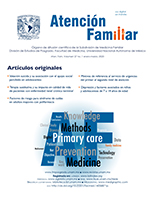Ideación suicida y su asociación con el apoyo social percibido en adolescentes
Contenido principal del artículo
Resumen
Objetivo: conocer la prevalencia de la ideación suicida y determinar la asociación entre la ideación suicida y el apoyo social percibido en adolescentes. Métodos: estudio transversal analítico. Se evaluaron 267 adolescentes de doce a diecisiete años de edad, ambos sexos, derechohabientes del Hospital General Regional con Medicina Familiar No.1, del Instituto Mexicano del Seguro Social (imss), en Cuernavaca, Morelos, México, que acudieron a la consulta externa de medicina familiar por cualquier motivo diferente de un trastorno mental. La obtención de la información de las principales variables de interés fue a través del cuestionario de ideación suicida de Beck y la escala de apoyo social percibido de Vaux. Se realizó un análisis descriptivo y se ajustó un modelo de regresión logística para evaluar la fuerza de asociación entre la ideación suicida y el apoyo social. Resultados: la prevalencia de ideación suicida fue de 16.48%. Se estimó una razón de momios (rm) de protección para ideación suicida rm = 0.37 (ic 95% 0.16, 0.84, p = 0.018) y 0.30 (ic 95% 0.12, 0.71, p = 0.006) del apoyo social medio y alto, respectivamente, en comparación con el apoyo social bajo. Asimismo, se observó que a mayor apoyo social percibido en los adolescentes mayor protección para ideación suicida (p de tendencia < 0.05). Conclusión: se detectó una alta prevalencia de ideación suicida y se determinó que a mayor apoyo social percibido menor ideación suicida en adolescentes. Estos hallazgos podrían ayudar a sustentar programas preventivos en el primer nivel de atención y sumarse a los esfuerzos de prevención del suicidio.
